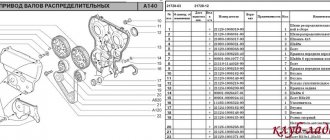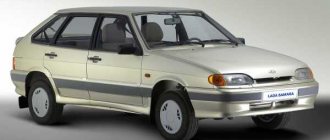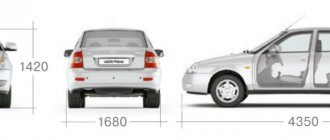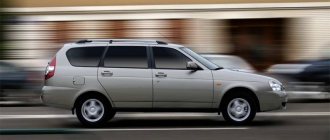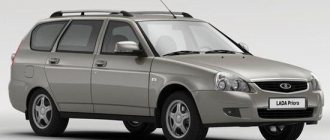When choosing a Priora, Toyota or Polo car, one of the first parameters that car enthusiasts pay special attention to is maximum speed, acceleration dynamics, and a strong, reliable engine. Acceleration to 100 km/h for the Priora is different, depending on the engine and body, as a rule, according to the passport - 11.5 seconds, 9.9 and even 9.5 seconds. A quick start is needed not only for racing competitions, but also for safe overtaking, as well as comfortable driving around the city. There are several ways to speed up the acceleration of the Priora - lightening the car, modifying the intake and exhaust systems, changing the firmware. But nothing will add power as much as tampering with the engine. For example, installing camshafts, turbines and non-standard throttle bodies. This is already a heavy tuning, it will increase both acceleration and wear of the engine - in this article we will not talk about it, but about acceleration at stock. Correct acceleration of the Lada Priora car from the factory.
For the Priora, acceleration to 100 km/h is recorded in the passport - many people look at this figure when they think about buying a car. This is a figure that was obtained under testing conditions at the test site. Also, when searching for a Priora, maximum speed can play a decisive role. This does not mean that you necessarily need to accelerate to the maximum - a motor with decent power will make movements more comfortable.
Acceleration time to 100 km/h according to the passport
- A sedan, hatchback, station wagon or coupe with 1.6 liter engines (98 and 106 hp) accelerates to hundreds in 11.5 seconds . A more powerful 1.8 liter (123 hp) power unit reduces the time to 9.9 seconds .
- The “Sport” version has a 1.6 liter engine with a power of 125 hp under the hood, which accelerates the car to 100 km/h in 9.5 seconds .
How are these values obtained? To determine the acceleration time to 100 km/h at the factory proceed as follows. There are 2 people in the car (total weight about 120 kg). The fuel tank contains only about 10 liters of AI95 gasoline. Starting from a standstill is not done from idle. The driver shifts gears with the skills of a professional. After 10 runs, the average value is determined and rounded.
Modifications (3)
| Model | Configuration | Max. speed | Acceleration 0-100 km/h |
| VAZ Priora I Sedan | 1.6 MT (81 hp), 120 N*m /2700 rpm. (2007 - 2013) | 183 km/h | 11.5 sec. |
| VAZ Priora I Sedan | 1.6 MT (98 hp), 145 N*m /4000 rpm. (2007 - 2013) | 183 km/h | 11.5 sec. |
| VAZ Priora I Sedan | 1.6 MT (87 hp), 140 N*m /3800 rpm. (2011 - 2013) | 176 km/h | 12.5 sec. |
Trunk volume and other features of the Lada Priora. Lada Priora station wagon trunk size. Lada Priora station wagon dimensions
Real measurements
Many car enthusiasts try to test acceleration to hundreds on their own. As a result, the measurement results may differ greatly from those indicated by the manufacturer. Why? Because the acceleration time to 100 km/h depends on many factors, for example:
- Driver skills
- Driving style (for example, at what speed does the gear change)
- Vehicle conditions
- Vehicle weights
- Weather conditions
- Type of road surface
- Accuracy of instruments measuring acceleration time
- etc.
Here are a couple of examples of self-measurements. The first test was carried out on a Lada Priora hatchback before restyling (acceleration time - 11 seconds ):
Another example is when the updated Lada Priora (FL) takes part in the tests. The authors try to determine the acceleration time to hundreds using a regular phone (results: 12.26 seconds and 15.12 seconds ):
Comparison with competitors
Acceleration time 0-100 km/h of Lada Priora competitors:
- Geely Otaka - 11.5 seconds.
- Chevrolet Lanos - 12.5 seconds
- Daewoo Nexia - 11 seconds
- Renault Logan - 13 seconds
- ZAZ Chance - 12.5 seconds
- Lada Granta - 11.8 seconds
How do you assess the dynamics of the Lada Priora? Take part in surveys, help determine the average acceleration time to 100 km/h, as well as the fuel consumption of this car.
Key words: Lada Priora engine
Share on social networks:
Found an error? Select it and press Ctrl+Enter..
Source
Driver surveys
To find out what kind of fuel consumption the Priora has per 100 km, it took observations from the drivers themselves, who were already able to verify the real figures in practice. These reviews are divided into several categories. Of 100 percent of respondents, most of the votes were given for the Priora's fuel consumption of 8-9 liters/100 km.
Further, with slightly fewer votes, we settled on data of 9-10 liters/100 km. The next results were consumption of 7-8 liters, which was voted for by one third of the drivers, the majority of those participating in the survey. Also, in the minority of votes, there were reviews (from large votes to small ones):
- 12 liters/100 km;
- 10-11 liters/100 km;
- 11-12 liters/100 km.
Lada Priora - acceleration to 100 km/h
Many motorists, before buying a vehicle, always study its characteristics - no one wants to buy a pig in a poke today. If we discard such important points as the power of the power plant and gasoline consumption, then after them we can highlight the dynamic performance of the car. And here you can encounter differences.
Let's imagine a situation - a buyer wants to purchase a well-known Lada Priora on the market. However, there are some doubts about the dynamics of this model. It’s not possible to conduct a test drive on site, but what to do then? Experts recommend always looking at the characteristics of the car, which are indicated in the passport. And here you need to look not at the engine power, but at the time it takes the car to travel 100 km/h. This is the only way to determine how the car behaves in motion.
Please note that sometimes the data indicated in the passport may differ from the real ones. Therefore, before purchasing, you should also read reviews of a specific car, in which the owners tell all the important information. If, again, we take the Lada Priora as an example, then in its passport you can see the following data:
- The sedan, hatchback, station wagon and coupe have a 1.6-liter engine. Acceleration time to 100 km/h is 11.5 seconds; in the same bodies a 1.8-liter engine may also be offered; it will take 9.9 seconds to accelerate;
- The popular “Sport” version on the market is equipped with a 1.6-liter power plant, which is capable of developing up to 125 hp. With this unit, Priora reaches 100 km/h in 9.5 seconds.
But where does PTS get such data?
In fact, the manufacturer takes measurements at the factory. To do this, 2 people, whose total weight is 120 kg, sit in the front row. After this, 10 liters of AI-95 fuel are poured into the gas tank. They don't take off from a standstill. Behind the wheel sits a professional driver who has gone through more than one test drive in his entire life. A total of 10 races are made in a row and the average result is derived from the data.
Many motorists, when buying this car, immediately check its dynamics. They get behind the wheel and try to accelerate to 100 km/h. The results, however, can be completely different - from 11 to 15 seconds. The thing is that car acceleration depends on a whole set of factors:
- motorist experience;
- shifting gears at certain speeds;
- vehicle condition;
- car weight;
- weather;
- quality of the road surface;
- road slope;
- operability of instruments that carry out measurements.
Experts recommend taking measurements according to the following rules. In first gear you need to start moving from 800 to 2000 rpm. On the second - from 2000 to 4000 rpm. The main rule is that you cannot accelerate the car at low speeds, this will push it back.
FakeHeader
Comments 32
Priora goes beyond 8 seconds “to hundreds”? Well, well... it reminds me of stories from the 90s when they were driving a “chisel” or “Zhiguli” with “full speedometer”)).
You probably haven’t seen any smart priors. Yes, read the entry first, I’m not sure about these numbers.
1. I have driven other “smart” cars and not only Basins. In particular, even 21106 with C20XE (note not C20XEV) does not leave 8 seconds. I don’t think there’s any need to explain what kind of motor this is? And compare it with a prioromotor. Every second less than 10 will be given with increasing difficulty, and getting out of 8 seconds will be more difficult than from 9. 2. I read the entry, otherwise I wouldn’t have written it
Pay attention to the parentheses at the end of the comment, they mean laughter, in particular at the measurement results. If you want to believe, believe, the main thing is not to disgrace yourself somewhere
Comparisons with k.l. “Boomer” or “Mercedes” who have seen better times don’t count. At one time, on a naturally aspirated 2.8, I tore up the Supra 3.0 turbo, but that doesn’t mean that I had such a super engine - it’s just that the owner of this Supra stupidly didn’t know that his engine was living out the last months of its life, and he also used it on every traffic light raped. But what’s funny is that no one except me risked racing with him)), for some reason everyone thought they would screw it up, but I didn’t give a fuck, because... It wasn’t a shame to lose to a sedan or sports coupe, but then at the next traffic light it looked like it had been dipped into the tank of a sewer truck a couple of times. What am I talking about? And if you want real, accurate results, go to drag and they will give you an accurate result.
You probably haven’t seen any smart priors. Yes, read the entry first, I’m not sure about these numbers.
there are no cars in Russia... it’s a fact, I’m talking about our auto industry... and smart Priors, half of the parts and components are there because of the “hillock”... it will no longer be a Priora... roughly speaking, it turns out to be a hodgepodge... I visited because of my “rotten” life (now I live normally) in many places, I thought, damn, we have Russian scientists, they are competitors in the world...after spending time or fooling around in graduate school, I realized a lot. It’s just that in Russia they don’t pay money, people plow for pennies... in short, any cross-eyed Chinese (they have communism there) will trash any Russian on any university subject... Americans, someone from TV (I won’t write the name, but there is one comedian there) says stupid ! nonsense...they are smarter than ours, we don’t have smart Vasyas and Petyas. how much I studied and am still learning... I realized one thing: nerds are not Russians, but any other nation. lan, at least I’m not Russian. We don’t have cars at all and never will...we don’t have nerds in the Russian Federation.
Priora goes beyond 8 seconds “to hundreds”? Well, well... it reminds me of stories from the 90s when they were driving a “chisel” or “Zhiguli” with “full speedometer”)).
first you need to find out what kind of wheels are on the car, what is on the car besides stock, what is not (maybe there are no seats in the cabin)?! then what kind of gasoline, what kind of engine oil, how long ago did you change it? driver weight! then take not a crooked Chinese program and a crooked iPhone, but a normal device and measure the acceleration up to 100! I don’t particularly trust the flight log, although it will be more accurate than what they wrote here. and about the satellites, this is nonsense... they don’t measure accurately... I know for sure that on the grant, according to the speedometer, the speed of 105 is actually 100 km/h, but if you measure it with an ordinary stopwatch, the accuracy will be small. again, the above parameters must be taken into account, especially if a person has just done a good flush himself, even 2-3 times and filled in good oil... well, mileage also plays a role... I have no doubt, I know the drain of the basin up to 127 engine, not one of 10 seconds won’t leave... people on YouTube don’t do anything, they measure it by the speedometer and they give 9.7 seconds. in real life, this is nonsense... if the basin goes stock for 10 seconds, then other foreign cars go stock for 2 seconds up to 100 km/h. nonsense! How many times have I driven on the basins, they don’t go at all... 30-40 years, what did AvtoVAZ do? foreign cars for the people (not racing cars, as many will think, but serial cars) already made 150 forces in the 90s, but in our country everything is made by 118 forces on a sport grant, and even then it’s not 118... the Aveo 1.6 stock will tear up this sport grant... we have Russian people they don’t want to work...they drink...they don’t want to study, or they don’t know how...I saw different people, learned a lot, drew conclusions...and the pelvis is a diagnosis!
What is the Priora's acceleration to 100 - how to accelerate correctly in a car
When choosing a Priora, Toyota or Polo car, one of the first parameters that car enthusiasts pay special attention to is maximum speed, acceleration dynamics, and a strong, reliable engine. Acceleration to 100 km/h for the Priora is different, depending on the engine and body, as a rule, according to the passport - 11.5 seconds, 9.9 and even 9.5 seconds. A quick start is needed not only for racing competitions, but also for safe overtaking, as well as comfortable driving around the city. There are several ways to speed up the acceleration of the Priora - lightening the car, modifying the intake and exhaust systems, changing the firmware. But nothing will add power as much as tampering with the engine. For example, installing camshafts, turbines and non-standard throttle bodies. This is already a heavy tuning, it will increase both acceleration and wear of the engine - in this article we will not talk about it, but about acceleration at stock. Correct acceleration of the Lada Priora car from the factory.
For the Priora, acceleration to 100 km/h is recorded in the passport - many people look at this figure when they think about buying a car. This is a figure that was obtained under testing conditions at the test site. Also, when searching for a Priora, maximum speed can play a decisive role. This does not mean that you necessarily need to accelerate to the maximum - a motor with decent power will make movements more comfortable.
Refinement of products of the domestic automotive industry
The firmware of the Lada
Priora engine when leaving the factory assembly line does not have a sports rigid suspension, which is required for the fastest possible start on sports cars. The suspension configuration affects such a concept as ground clearance (the distance from the surface to the lowest central point of the car), which for cars of this brand is at least 17 cm under the bottom and 13.5 cm under the exhaust system.
To modify the suspension, the Lada Priora can be equipped with shorter and stiffer springs (you can cut the standard ones by one and a half turns, but they will not last long). Next, you will need to replace the hydraulic struts that stabilize the car when it hits an uneven surface. The struts must match the springs. In addition, for sporting events you need a sports stabilizer with a large cross-section and bushings made of hard material, polyurethane, and special suspension arms with silent blocks, also made of polyurethane. The combination of these measures allows us to form a new suspension, which gives more opportunities to quickly accelerate to 100.
The shape of the car itself, which is far from the lines of a racing car, also plays an important role for the Priora when picking up speed. It is improved compared to models of previous years, where the drag coefficient reached 0.31 (in modern cars - 0.28) due to the formation of a sharper angle of inclination of the hood and windshield, and less lagging side mirrors. The wheel arches of the Priora model do not protrude much, the rear and side parts are evenly smoothed. The assembly is good - there are no large gaps, the radiator grille is a closed configuration and small, there are no particular complaints about the unevenness of the bottom. All this taken together allows us to assert that the Priora’s data helps it accelerate to 100 km/h in the minimum time possible with this configuration.
Priora accelerated to 200 km. h.
It is known that air resistance begins to significantly affect the car at a speed of 80 km/h, so in the first ten seconds of driving the car system already begins to withstand these loads.
Acceleration time to 100 km/h according to the passport
The acceleration time and maximum speed of the Lada Priora car largely depends on the combination of the engine and gearbox. Priora is equipped with three types of gasoline engines with a displacement of 1.6 hp. (eight-valve, sixteen-valve), and the restyled VAZ-2170 is equipped with three other types of 1.6-liter engines, as well as a new one with a volume of 1.8 liters and a power of 123 hp.
As for the gearbox, the standard, beloved by all mechanics is installed; after restyling, you could also choose a robotic gearbox - Jatco automatic transmission. There are a lot of options - combinations, but the most common is the choice of a manual transmission with a sixteen-valve 1.6-liter engine with a power of 98 hp.
For him, the passport states that the maximum speed of the VAZ-2170 for all body types (station wagon, five-door hatchback, sedan) is 183 km/h, acceleration to hundreds is 11.5 seconds. Pay attention to the indicators for Lada Priora sport - a special edition of the VAZ-2170.
1.8 hp engine works only with mechanics. The car goes up to hundreds in just 10 seconds, and the maximum speed is 190 km/h.
Characteristics
The engine can be one of two types at the buyer's choice: either 1.6-liter or 1.8-liter. Their power will be 106 horsepower or 123 hp. respectively. Both engines are petrol.
As for the gearbox, you can choose either a 5-speed manual gearbox or a 5-speed robotic gearbox of your own production. The drive will be in a single design: on the front pair of wheels.
AvtoVAZ emphasizes that their engineers worked on the new product, taking into account the characteristics of Russian roads (that is, the suspension promises to be improved). Acceleration to a speed of 100 kilometers takes 11 seconds, which is quite good for such a device. In addition to the innovations described above, it is worth noting the use of high-quality sound insulation, which will significantly reduce the noise in the cabin.
For driver safety, the Lada Priora 2022 will be equipped with an airbag that will be installed in the steering wheel. Apart from the driver's airbag, there are no other airbags in the cabin. However, good safety is ensured by the reinforced body frame, including in the area of the side doors. In addition, energy-absorbing airbags are installed under the front bumper.
The manufacturer promises a reduction in fuel consumption - 6.5 liters per 100 kilometers at a minimum.
Why does Priora jerk when accelerating, jerks in motion?
The car should accelerate smoothly. The car jerks, this is either due to your switching, or to the box itself. Jerking is usually present on a faulty machine. But if Priora is in good working order, it will show a fairly decent result. Everything will depend on the skill of the driver. In addition, the following parameters must be observed in order to repeat and exceed the performance from the test site:
- vehicle weight;
- weather;
- quality of road surface;
- driving style;
- the accuracy of the stopwatch with which acceleration time is measured.
If, when all these conditions are met, it is not possible to achieve a normal acceleration time and jerks appear, you need to change the gear shift process. This problem can also occur with automatic transmissions - for an automatic transmission this is almost a standard problem that needs to be repaired.
How to fix jerking, what to watch
When jerks appear when accelerating and even at low speeds the Priora jerks, you need to first try a smoother shift when accelerating, “listen” to the car. If jerking persists during smoother gear changes and stable acceleration, pay attention to the gearbox and clutch basket.
The oil inside the gearbox must be changed on time, and it itself must be clean so that the gears shift cleanly. The slide must not be damaged - all grooves must be visible, and the corners must not be smeared. A burned clutch is a surefire way to delay gear shifting. After correcting all the problems, you can begin to learn how to overclock.
How to properly accelerate in a Priora
The skill of correct acceleration will be similar to playing sports: first you need to learn the theory, then try to make the movements slowly. Only after this should you try to make the correct acceleration. The main work will be done to get the speed right.
During everyday driving, almost every driver changes gears with a movement practiced to the point of automaticity, which may be lubricated - the transmission does not shift at the right moment, but the car will still go. During this moment, her speed will drop, which cannot be allowed. The Priora's engine needs to be turned so that it moves - and there is no drop in speed.
The scheme is as follows:
- in first gear you need to start from 800 to 2 thousand rpm;
- on the second - from 2 to 4, then the third: from 4 to 5 thousand revolutions. The key is don't under-rev and don't push the car too hard.
Option two:
Remember that from 2 to 4 thousand is the maximum torque of 126 motors, then the torque decays. You need to hold out for this second, switching strictly “like in a driving school.” You'll have to perfect your movements. With such acceleration, you will reach one hundred in third gear. Consumption will not increase much if acceleration is smooth.
Why may Meizu slow down?
In addition to the power of the processor and graphics core, the following problems affect the performance of a smartphone:
- Presence of resource-intensive applications in background processes. They take a certain part of the resources themselves, preventing the game from fully using the power of the device. To eliminate these, it is advisable to launch the task manager more often and clean the processor of unnecessary programs.
- RAM fullness. All running processes are placed in RAM and occupy space there. The free memory in the RAM may not be enough for the game - it will take a long time to load and hang.
- The internal memory of the mobile phone is clogged. This affects the performance and operation of the operating system as a whole.
- Overheat. High temperatures reduce power, which affects the number of fps in games or videos.
Because of all this, meizu slows down not only in games, but also on its own. So you shouldn't let your phone get into this state.
What makes sports cars start quickly?
In order to start quickly, the car must be light. For example, Lada Priora, a sports hatchback, has a curb weight of 1088 kg and almost all parts of its body are made of galvanized or stainless steel. In global production, to reduce fuel consumption and increase the speed characteristics of sports cars, bodies are made on the basis of aluminum frames using composite materials and carbon fiber (40% lighter than metal), which allows, for example, the Hennessy Venom GT model to accelerate to 100 km/h. in two point seven seconds.
Of course, such fantastic acceleration occurs on supercars due to the fact that they have an engine of a different order than the Lada Priora. The same “Hennessy Venom” has 1244 horsepower under the hood and a volume of 6.2 liters versus ninety-eight “horses” of the Priora family. That is, the difference is more than 10 times, despite the fact that Venom weighs only 180 kg more and costs 100 times more than a product from the domestic automobile industry.
However, even for cars with the same engine displacement, acceleration to 100 can be achieved in different times. Sometimes even a Lada Priora can run faster than a more powerful model, which “wake up” only when the tachometer (determines the number of revolutions of the rotating parts of the car, its engine) approaches the middle of the scale. And the point here is the different elasticity of the engine, which is expressed in different torque characteristics.
Torque, as we know from school physics, is the product of the force applied to the lever and the length of the lever itself. In the Priora, like in other cars, torque occurs when the mixture of air and fuel, after pressing the gas pedal, burns in the chamber, and the vapors expand and press on the piston. Then the connecting rod mechanism translates the reciprocating movements into revolutions of the crankshaft - this is how rotation appears, realizing torque.
This vector physical quantity can be different at different speeds, and is involved in creating the traction force, which moves the Lada car when the traction overcomes the force of the car’s own gravity, air resistance, etc.
How much does a VAZ (Zhiguli, Lada, Niva) car weigh?
Model Curb weight, kg Permitted maximum weight, kg
| VAZ-2101 | 955 | 1355 |
| VAZ-2102 | 1010 | 1440 |
| VAZ-2103 | 955 | 1355 |
| VAZ-2104 | 1020 | 1475 |
| VAZ-2105 | 995 | 1395 |
| VAZ-2106 | 1045 | 1445 |
| VAZ-2107 | 1030 | 1430 |
| VAZ-2108 | 900 | 1325 |
| VAZ-2109 | 945 | 1370 |
| VAZ-21099 | 970 | 1395 |
| VAZ-21011 | 955 | 1355 |
| VAZ-2110 | 1010 | 1485 |
| VAZ-21102 | 1020 | 1495 |
| VAZ-21103 | 1040 | 1515 |
| VAZ-2111 | 1040 | 1540 |
| VAZ-21111 | 1030 | 1530 |
| VAZ-21113 | 1060 | 1560 |
| VAZ-2112 | 1040 | 1515 |
| VAZ-21122 | 1020 | 1495 |
| VAZ-2113 | 975 | 1400 |
| VAZ-2114 | 970 | 1395 |
| VAZ-2115 | 985 | 1410 |
| VAZ-2121 | 1210 | 1610 |
| VAZ-2170 Lada Priora | 1088 | 1578 |
| VAZ-2170 Lada Priora station wagon | 1088 | 1593 |
| VAZ-1118 Lada Kalina | 1070 | 1545 |
The curb weight of a vehicle is the weight of a vehicle with standard equipment, various consumables (oil, coolant, etc.), but minus the weight of passengers, driver and luggage.
Dry weight is equal to curb weight, but only without fuel, some equipment and consumables. That is, this is the mass of an unloaded vehicle without fuel.
The permissible gross weight is the weight of the maximum loaded vehicle provided by the manufacturer. This is sometimes called the maximum permissible mass. It is better not to go beyond the limits of this indicator, unless, of course, you want your car to last for a very long time. The increased load has a negative impact on the car body and suspension parts.
What does the initial acceleration depend on?
The traction force of the Priora depends on the gear ratio in the gearbox, the so-called transmission. The latter consists of a clutch (the connection between the gearbox and the engine mechanism), drive shafts and a gearbox, which transfers power and torque from the engine to the wheel shafts. Gear ratios can be of: 2 types.
| Gear ratio | |
| Short | many teeth on gears |
| Long | small number of teeth |
If you need quick acceleration to 100, then use gear ratios with a short ratio.
Lada dashboard
In addition, the Lada can accelerate faster if the number of the main pair is increased (for this family the standard number is 3.7). It is believed that setting the pair to 4.1 or 4.3 allows you to get a noticeable (but is it necessary) advantage for breaking away at a traffic light, and sports models are equipped with modifications with numbers 4.7 or 5.1 (for crossovers). Cars used in urban environments, where acceleration to 100 is not necessary, are equipped with a gearbox with a balanced series of gear ratios, which does not provide rapid acceleration, but provides high speed, if necessary.
It is worth remembering that not every Priora will withstand the load from additional numbers for a long time with a standard clutch. That is why when tuning you need to install more durable and reliable components that are produced by AP LockheeD or “Luk”. You should also think about purchasing high-stiffness springs and cermet discs for the clutch basket. In addition, to reduce the load on the clutch, crankshaft and gearbox, you can install a lightweight flywheel for the Priora, which is on average 2-3 kilograms lighter than the standard one (additional fuel savings). But experts do not recommend lightening the crankshaft, because in a garage, or even most car repair shops, it is impossible to select balancers for the connecting rod journals for a new shaft, which can lead to the collapse of the entire system.
Lada Priora has a slower acceleration to 100 kilometers per hour than, for example, a rear-wheel drive model with the same engine characteristics, since the basic configuration of this car is not intended for sports. Therefore, it has a lighter torque transmission design and no cardan, which adds greater controllability and efficiency to this urban car.
Car equipment
The crossover is available in the following variants:
– engine – turbocharged TSE series with a volume of 1.3 liters and a power of 150 hp. or naturally aspirated with a volume of 1.6 liters and a power of 114 hp;
– transmission – X-TRONIC CVT or manual gearbox (5 and 6 speed);
– drive – full or front.
Among these characteristics, special attention should be paid to the transmission, namely the continuously variable transmission (variator). The unit has a specific job, which ensures smooth movement of the car and the absence of jerks and jolts at the moment of start
When you press the gas pedal sharply, such a box allows the engine to gain high speeds, but rapid acceleration does not occur. That is, with a CVT Renault Arcana, acceleration will be somewhat slower. However, this only applies to the combination of a continuously variable transmission with a conventional engine. The turbocharged engine compensates for this deficiency.
We tune the Priora to quickly accelerate to 100!
Acceleration to 100 can be reduced in time terms if, to reduce the moment of inertia of the wheels, the Priora is equipped with lightweight wheels that comply with the manufacturer’s recommendations (reduce the overall weight) and that do not have too large cutouts (aerodynamics).
You can also install the widest possible tires, but at the same time the lightest possible specifications 175/65 r 14, 185/60 r 14 or 185/65 r 14 (increase the contact patch with the road), and try to set records on heated tires. To do this, you need to drive for about 10 minutes before the control run, as is done in Formula I races, or perform wheel slip.
Acceleration to 100 km/h in less time is possible for the Lada Priora model if the number of gearbox stages is increased from the standard five to six. In this case, you can buy a ready-made assembly of a number of gears with the following parameters: for the first gear 3.17 (38/12), for the second – 2.11 (40/19), third – 1.48 (40/27), fourth – 1 .13 (35/31), fifth – 0.89, sixth – 0.78 with row 18. This configuration provides trouble-free dynamics during acceleration, but will cost the owner of the Priora 13-14 thousand rubles. for parts and about 6-7 thousand rubles. for work in the workshop.
Suzuki Jimny
Immobilizer Lada Priora VAZ 2170
The compact Japanese SUV Suzuki Jimny (from 1 million rubles) came close to the podium. This car occupies an exceptional niche in the market as the smallest body-on-frame SUV, but let's be objective - it's too slow. The Jimny has only one engine - 1.3 liters and 85 hp. and when combined with an automatic transmission, it gives the Jimny a 0-60 mph time of 17.2 seconds. Actually, the small dimensions of the engine compartment limited the engineers of the Japanese company in engine volume. The design of the Jimny has not changed for decades, but for the evolution of “rogues” who are gradually losing their off-road potential, this is only a plus and the Jimny can safely be called one of the last “honest SUVs.”
Problems when installing an additional sixth gear
If you decide to put sixth gear on your Lada Priora yourself in order to accelerate to 100 kilometers per hour faster on the road, then you need to take into account, for example, that during the assembly the gears for 5th and 6th gears on the input shaft will be a single unit, additional costs will be required for roller gears and needle bearings, stabilizer locking rings, retaining rings, studs (possibly M8 size), spacer rings, synchronizer hub for 1st-2nd gears, etc. In addition to the set of tools usually used for overhauling the Priora gearbox, the car enthusiast will need a 6-point wrench for “12” ", a grinder, a thread locker and maybe a drill with a cutter.
To ultimately achieve a faster 0-60 mph time, the car can undergo a number of difficult modifications when installing sixth gear. The Lada Priora gearbox may not allow you to immediately install the fifth gear gear, because there may not be enough space for the needle-shaped bearing (you will have to grind the bearing or spacer ring with a grinder). The bushing may have to be pressed onto the output shaft using a hammer, and the synchronizer hub may be lost.
When installing the sixth gear gear from the secondary shaft on a Lada Priora, you may be faced with the fact that you will have to remove the bearing from the assembly, and when closing the gearbox cover, you may have to grind it down so that it does not touch the raised steel plate. In addition, when we put the gearbox redesigned for “acceleration to 100” back into the car, it may affect the spar, and it will require sawdust or the installation of special engine mounts that make its location lower with the gearbox. Therefore, for a faster start at a traffic light, you need to pay decent money or have high qualifications in order to carry out all the work yourself and without harm to the car.
Source



